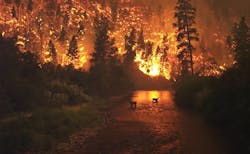Fire resistance of metal cladding is an asset in wildfire-prone areas
The Western U.S. has had to cope with more damaging, large-scale wildfires in recent years. The number of wildfires larger than 1,000 acres in the region stretching from Nebraska to California increased by a rate of seven fires a year from 1984 to 2011, according to a study published in Geophysical Research Letters, a journal published by the American Geophysical Union.
Decades of fire suppression practices that have preserved fuel and large-scale climate changes could be driving increases in fire activity, the report says. The changes in fire activity are in line with long-term, global fire patterns that climate models project will occur as temperatures rise and droughts worsen in future decades due to global warming.
Construction projects in fire-prone areas need to take this danger into account. Cladding materials on structures near forested areas in the West should be fire resistant. Fire resistance of building materials is defined in many ways including ignitability, having resistance to simulated fire conditions for a given period of time, and the most stringent: the ability to isolate a fire completely and continue to support a structure as it burns, often described as a “fire wall.”
Metal cladding excels in resisting ignition and is commonly used as part of a fire-resistant assembly due to that trait. According to the International Building Code, metal panels, when installed over open framing or a non-flammable substrate, are rated Class A for external fire exposure—the highest rating.
In their test standard UL 790, Underwriters Laboratories states, “Class A roof coverings are effective against severe fire test exposures. Under such exposures, roof coverings of this class afford a high degree of fire protection to the roof deck, do not slip from position, and are not expected to produce flying brands.” Leveraging this aspect in high fire danger areas where an abundance of dry wood is a lightning strike away from a conflagration, metal panels provide designers with a sound choice of fire-resistant exterior material bearing a wide palette of colors.
About the Author

Ken Buchinger
Ken Buchinger is the General Manager of Technical Services for MBCI. He began working at MBCI in 1988, and throughout his tenure he has been responsible for handling field problems, developing weathertightness warranties, erector training, research and development certifications, and the creation and management of the MBCI installation manuals and catalogs. Buchinger is actively involved in several trade associations and has written numerous articles for various trade magazines and gives presentations for various organizations. Prior to working at MBCI, Buchinger was part owner of Whitehouse Construction Company and erected metal buildings for Brown Erection Company.
